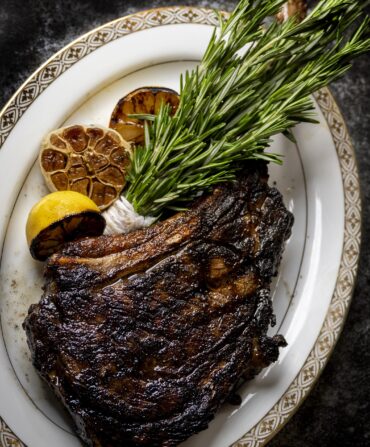For the last eight weeks I’ve received an e-mail with the subject line “What’s your address? (sending you a cookbook)…” from an outfit called Paleo Reboot. Every day, I dutifully unsubscribe, report the message as spam, and delete, and every day I get another one. (I realize I could avoid many such irritating missives by getting rid of my AOL account, but old habits die hard and I’ve decided it’s cool rather than lazy to be a holdout.) I have no intention of sending these people my home address, but I finally did take a look at the website, where I discovered a young man named Dr. Ryan Lazarus (not an MD, exactly, but rather a “certified practitioner of functional medicine and Doctor of Chiropractic”), who was touting books related to the phenomenon that is the Paleo diet.
For those of you who have been living under a rock—or who long ago abandoned AOL—the Paleo diet is a high-protein, high-fiber eating plan that purports to mimic the habits of our ancestral hunter-gatherers by eliminating dairy, refined sugar, legumes, cereal, grains, potatoes, and beef from cows that have dined on anything but grass. The premise (and promise) is that making like a caveman will enable you to get lean and all but eliminate the risk of heart disease and diabetes, along with a whole host of other ills. There has been much back-and-forth about the pros and cons of such a diet, with one of the biggest cons (yep, that’s a pun) being that no one could possibly know what the real Paleo diet actually consisted of and that different groups ate different stuff. Aboriginal Australians dined primarily on animal products, for example, while the Kitavans of Papua New Guinea ate fish and coconuts. Also, not only have our genes changed more in the last ten thousand years than Paleo proponents would have us believe, but also so have the species of fish and fruit, etc., that early man ate. Whatever. I’ll try anything for a week or two, but I have no intention of living a life devoid of—just to name a few—rice and gravy, lady peas, butter beans, biscuits, ice cream, yeast rolls, steak frites, or cheese (especially when it’s paired with the very fine sourdough baguettes or ciabatta made by the talented Michael Bridges, baker extraordinaire at the Modica Market in Seaside, Florida, where I spend a lot of time).
Instead, when it comes to ancestors, I prefer to draw on the eating habits of my more recent—rather more evolved—ones, including my paternal great-grandfather Sterling Price Reynolds, who died at age 106, and my three great-aunts who lived well into their nineties. My father grew up in the home of Mr. Reynolds (as he was mostly called, even by his best friend and brother-in-law, Uncle Gideon Crews), a sprawling place near the banks of the Mississippi River in Caruthersville, Missouri, that housed three generations of family. Even though Daddy recently turned eighty-eight himself, he can still recall, with vivid accuracy and enthusiasm, the three daily meals taken at his grandfather’s table. “Doctor” Lazarus, as well as Loren Cordain, the PhD and professor emeritus who is the self-declared “founder of the Paleo Diet Movement,” would be appalled by every one of them.
Right off the bat, breakfast, which was always served at 7:00 a.m. sharp, was full of Paleo no-nos. There was fruit (acceptable), but it was invariably topped off with the cream left over from the daily churning of butter, as was the oatmeal (unacceptable). To add to these sins, there were eggs (acceptable), but they were fried in the aforementioned butter and accompanied by cured ham (there was a smokehouse) and bacon or both (Cordain recommends uncured pork chops instead). The noon lunch was even worse: chicken and dumplings, fried catfish, or a roast of red meat carved at table, except on Sundays, when there was usually fried chicken; spoon bread or fried hot-water cornbread (slathered with butter); greens and/or field peas cooked with cured ham hocks, plus all the vegetables in season from the garden. Dinner, at six, was a slightly more formal affair. There would be beefsteak or quail, all manner of potatoes, plus yeast rolls and biscuits and sometimes popovers too. Paleo-friendly additions included oysters off the overnight train from New Orleans, fresh spinach or asparagus from the bed, watermelon every night in summer, and ambrosia for dessert—but even the ambrosia got doused with cream.
The beverages would also have been highly alien to Homo habilis. Hot coffee was served during breakfast, iced tea (albeit unsweetened) during lunch and dinner, with more hot coffee served afterward. Before dinner the grown-ups enjoyed a highball (or two or three) of bourbon. This often took the form of an old-fashioned, which I’m pretty sure was made with regular old refined sugar as opposed to the coconut syrup used in the version posted on paleococktails.com. While the good professor Cordain is opposed to caffeine and frowns on distilled spirits and wine with sulfites (which is pretty much all of them), he graciously allows his nonobese followers to cheat 15 percent of the time.
Mr. Reynolds didn’t smoke, but his daughter, my grandmother, was a lifelong smoker, as was her husband and his sisters, the long-lived great-aunts. (We’ll never know how long my grandparents would have hung around—they were in their eighties and as healthy as horses when they were killed in a car crash.) I was especially close to my aunt Margaret, who celebrated her ninetieth birthday at a big bash, where she was photographed with her “little” sisters Helen and Jessie (both in their late eighties) sitting side by side on a sofa. Each woman is holding a highball and a cigarette, with their cigarette “purses,” those old-fashioned snap-top things with side pockets for lighters, positioned prominently in their laps. I never saw Aunt Margaret without hers, and as a child I was forever entertained by that popping sound her lips made against the filter as she wrenched the last possible drag out of her Benson & Hedges 100.
Now, let me hasten to add that I’m not for one minute advocating smoking—I know way too many people not nearly as lucky as the aunts. I’m just saying (and hoping like hell) that a lot of this is luck of the gene-pool draw. (And in Aunt Margaret’s case, the bourbon and tobacco might very well have been offset by the fact that she never married or had children—she was an extraordinarily cheerful human.) But I do think we Homo sapiens could be okay with a slightly longer view than that taken by Professor Cordain. His list of non-Paleo foods that adversely affect the health of humanity includes but is not remotely limited to potato chips, tacos, hamburgers, french fries, doughnuts, chips and salsa, sandwiches, sausage, pancakes, and pizza—in short, “just about any other product man/woman has their hand in producing.” At this rate, we’ll be picking blueberries off bushes with our teeth.
Cordain clearly has a tiny tendency toward the pompous, so I’ll just respond by noting that I am profoundly grateful to the “man/woman” who figured out pretty early on that the noble pig would taste mighty damn delicious if you took your hands and salted and cured various cuts of him, notably his belly and his haunch. Bacon and country ham are, as noted, on Cordain’s list of stuff that is adverse to our health, but in this he is not alone. A year ago, the International Agency for Research on Cancer (IARC), a World Health Organization group, announced its findings that the consumption of processed meat (anything “transformed through salting, curing, fermentation, smoking, or other processes to enhance flavour or improve preservation”) causes cancer, and the consumption of red meat “probably” does.
Not surprisingly, the North American Meat Institute posted a host of studies that found differently. There was even a series of YouTube videos featuring the senior vice president for public affairs calmly telling viewers that “it is IARC’s job to find cancer hazards,” and that so far the outfit has found “sunlight, breathing air…working in a barbershop” all to be causes of the disease. Both camps have a point. If you bake yourself in the sun, you might get skin cancer and die. But my great-grandfather had a daily serving of cured and red meats (and alcohol), and he led the parade, on foot, that marked his one hundredth birthday.
Though there was a lot of hoopla when the study came out, it seems unlikely that my fellow bacon lovers are going to give it up anytime soon. Americans eat an average of eighteen pounds of bacon a year, each. If you remove the vegetarians, vegans, and some Paleo dieters from the list, that means many of us are eating a highly disproportionate share of the roughly 5,760,000,000 pounds of pork strips consumed across the country each year. And that’s not even counting the Canadians. In a recent poll, 43 percent of our brothers and sisters to the north said they preferred bacon to sex.
Also, it turns out that bacon has some health benefits of a sort. A study at the International Centre for Life at Newcastle University in England examined why the classic English bacon sandwich (a “bacon butty”) was a near perfect treat to cure a hangover. The researcher Elin Roberts told the Telegraph, “Bread doesn’t soak up alcohol but is high in carbohydrates that boost blood-sugar levels and speed up the metabolism, helping to get rid of alcohol quickly. Bingeing on alcohol depletes brain neuro-transmitters but bacon, which is rich in protein, contains amino acids that top these up, giving you a clearer head.”
Gwyneth Paltrow would most likely say it’s all about finding your balance, but I’d bet big money that the whole time she lived in London with Chris Martin, she never ate a bacon butty. Me, I’m gonna take my chances. One of the world’s great pleasures is a dry martini, up, before moving along to a perfectly cooked steak and a bottle of a fairly big red. And then there is the trifecta of Paleo contraband, the pimento cheese dog at Atlanta’s Varsity. Bread/cheese/dog equals a Paleo nightmare, but for many of us, it’s heaven in a bite. Sadly, our more distant ancestors, who lived, at most, to the ripe old age of forty, never had the pleasure.








